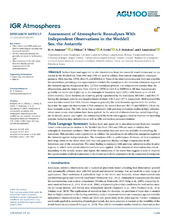Assessment of Atmospheric Reanalyses With Independent Observations in the Weddell Sea, the Antarctic
Jonassen, Marius Opsanger; Valisuo, Ilona; Vihma, Timo; Uotila, Petteri; Makshtas, Alexander, P.; Launiainen, Jouko
Peer reviewed, Journal article
Published version

Åpne
Permanent lenke
https://hdl.handle.net/1956/22943Utgivelsesdato
2019Metadata
Vis full innførselSamlinger
- Geophysical Institute [1223]
Originalversjon
https://doi.org/10.1029/2019jd030897Sammendrag
Surface layer and upper‐air in situ observations from two research vessel cruises and an ice station in the Weddell Sea from 1992 and 1996 are used to validate four current atmospheric reanalysis products: ERA‐Interim, CFSR, JRA‐55, and MERRA‐2. Three of the observation data sets were not available for assimilation, providing a rare opportunity to validate the reanalyses in the otherwise datasparse region of the Antarctic against independent data. All four reanalyses produce 2 m temperatures warmer than the observations, and the biases vary from +2.0 K in CFSR to +2.8 K in MERRA‐2. All four reanalyses are generally too warm also higher up in the atmospheric boundary layer (ABL), with biases up to +1.4 K (ERA‐Interim). Cloud fractions are relatively poorly reproduced by the reanalyses, MERRA‐2 and JRA‐55 having the strongest positive and negative biases of about +30 % and −17 %, respectively. Skill scores of the error statistics reveal that ERA‐Interim compares generally the most favorably against both the surface layer and the upper‐air observations. CFSR compares the second best and JRA‐55 and MERRA‐2 have the least favorable scores. The ABL warm bias is consistent with previous evaluation studies in high latitudes, where more recent observations have been applied. As the amount of observations has varied depending on the decade, season, and region, the consistency of the warm bias suggests a need to improve the modeling systems, including data assimilation as well as ABL and surface parameterizations.
